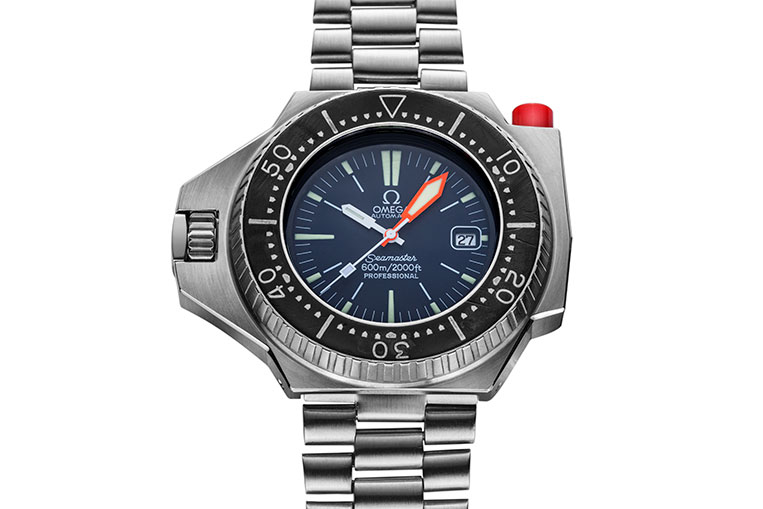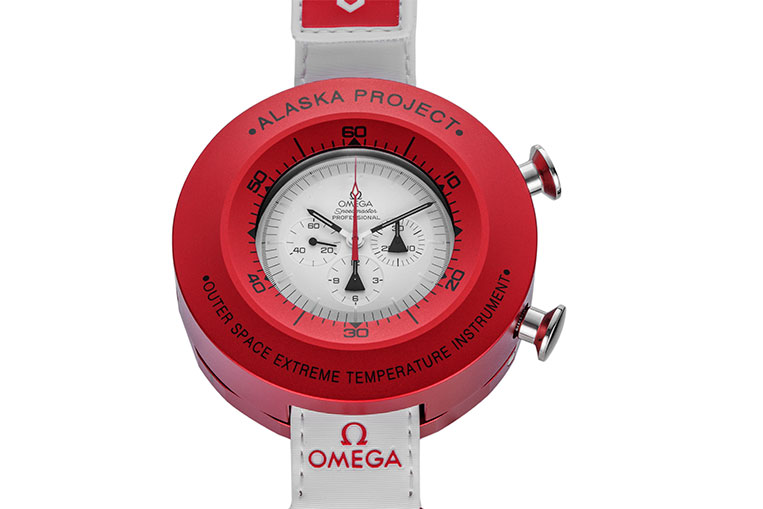Feature: 5 Weird Omega Watches
There's no doubt about it— Omega has made some of the most iconic timepieces ever seen, been involved in moments that have defined history as we know it today. Omega has made a lot of other timepieces as well, some more unusual than others. Here's a selection of some of the strangest.
Omega Speedmaster Moonwatch Anniversary 311.30.42.30.99.002
Omega has been synonymous with space flight ever since astronaut Wally Schirra wore his Speedmaster 2998 during the 1962 Mercury-Atlas 8 mission. Of course, the most famous space Omega has to be the ST105.012, the first watch on the moon, worn by Buzz Aldrin during the legendary Apollo 11 mission in 1969.

Omega Speedmaster Moonwatch Anniversary 311.30.42.30.99.002
But what about the last Speedmaster worn on the moon? By 1972, with budgets drying up and the Space Shuttle programme demanding attention, Apollos 18, 19 and 20 were cancelled, with Apollo 17 to be the last time humans ever set foot on that 3,500km-wide rocky body orbiting Earth.
When astronauts Eugene Cernan, Harrison Schmitt and Ronald Evans left Earth under the cover of darkness, following a delay caused by a malfunction in their gargantuan Saturn V rocket, they took the Apollo programme to the moon one last time, and they made it count. While Evans orbited in the lunar module, Cernan and Schmitt—the first and only scientist on the moon—travelled 19 miles in the lunar rover, collected over 110kg of rock and soil samples, and deployed an experimental package that continued to transmit data back to Earth for several years. Cernan also left his daughter's initials drawn in the dust, before taking mankind's last steps on the moon.
The safe touchdown of the command module on the evening of the 19th of December marked the end of an era, but it's one Omega clearly doesn't want forgotten, because for the 40th anniversary of the Apollo 17 mission, the brand released this limited edition of 1,972.
Mission anniversary edition Speedmasters are no new thing—a 45th anniversary edition has since followed—but what makes this one so unique and unusual is the size of the mission patch in relation to the dial. Usually the patch sits with the running seconds in the nine o'clock sub-dial, but here the patch is the dial.
Designed by artist Robert McCall, it features Apollo, the Greek sun god, and behind him, space. An eagle, wings resplendent as the American flag, the three stars above its stripes symbolising the crew, touches the moon, their destination.
It's a bold decision to place this iconography so prominently on the dial, and while the aesthetics may divide opinion, it seems a fitting commemoration to the mission that closed the door on the most famous, impassioned and incredible chapters of exploration history.
Omega Seamaster Polaris Albertville Barcelona 1992 2597.50.00
Sometimes you can tell when something was made just by looking at it, and Omega's Polaris is most definitely one of those designs. Created in the 1980s, it emerged in a tumultuous time when mechanical watches had become obsolete, Swiss craftsmanship set aside for Japanese precision. But the Swiss fought back, and the Polaris was one of the weapons it fought back with.

Omega Seamaster Polaris Albertville Barcelona 1992 2597.50.00
Launched ahead of the 1988 Seoul Olympic Games, Omega was desperate to maintain its mantle as Olympic timekeeper, a title held since 1932. Through the years, following the brand's first appearance at an Olympic Games with just one man and some stopwatches, Omega has produced a number of technological developments that have moved timekeeping into greater and greater realms of precision.
1948 saw Omega's introduction of a photoelectric cell-based automatic timing system, which in 1949 was linked to a photo finish camera. In 1952, development in electronic computers allowed Omega to increase the accuracy of its timing to one hundredth of a second. Then came the Omegascope for 1964, which superimposed Omega's timing onto television screens around the world. Swimmers benefitted in 1968, when Omega created a touchpad that allowed swimmers to stop their own clock. 1992, and Omega's timing increased in accuracy by a decimal place, offering precision up to a thousandth of a second. The electronic starting pistol came in 2010, followed by 2012's Quantum Timer, pushing accuracy to one millionth of a second. For Omega's Olympic legacy to stay alive, its wristwatches had to remain relevant. The result was the Polaris.
But what's most fascinating about the Polaris collection isn't its quartz movements, which vary from traditional analogue layouts to multi-display analogue-digital hybrids, but its appearance. The lozenge-shaped case and its integrated bracelet were clearly intended to look futuristic, to encourage shoppers that the brand hadn't lost its relevance, buts it's the combination of materials that really sets this watch apart from anything else in existence.
Whether in titanium and gold or steel and gold like this 1992 Barcelona Olympics edition, what you got with the Polaris collection was a two-tone band that circled the dial and spread across the case. It may seem that these bands are plated, anodised perhaps, but what we're actually looking at here are 2mm thick strips of 24-carat gold inlaid into the case. Omega never revealed exactly how this was achieved, so it remains an unusual and intriguing mystery to this day.
Omega Racend Timer Specialities Museum 516.53.39.50.02.001
Talking of the Olympics, here's another Olympic tech-inspired watch straight from the Omega Museum collection: the Racend Timer. The Museum Collection must not be confused with Omega's museum collection—that is, Omega has a physical museum in Biel that houses over 4,000 classic Omega watches, one of which this watch is a recent reedition of, forming part of a collection of historical reeditions that Omega calls the 'Museum Collection'.

Omega Racend Timer Specialities Museum 516.53.39.50.02.001
To compound the confusion further, the original Racend Timer of 1948 looked nothing like this relatively unassuming, albeit attractive, museum piece. A 39mm rose gold case, silver opaline dial with red pulsometer and blue tachymeter tracks, and a co-axial calibre 3201 beating inside are all very well and good, but the 1948 Racend Timer was actually a device built to capture photo finishes at the Olympics. That's 'Racend' as in 'race end'.
Using a photoelectric cell, which generates current when triggered by light changes—you may have seen something similar on touchless taps and toilet flushes—Omega was able to pinpoint the exact moment an athlete crossed the finish line. In 1949, Omega joined forces with the British Race Finish Recording Company to combine its photoelectric timer with a slit photo finish camera. The result was the Racend Timer, a photo finish camera triggered by the athletes themselves.
Which, of course, looked nothing like this watch. Presumably inspired by period chronograph timepieces, the reissue Racend Timer remains a bit of a mystery amongst Omega's collection. Looks good, though.
Omega Seamaster Plongeur Professionnel 'PloProf' 166.0077
The Rolex Sea-Dweller is, without a doubt, the most successful dive watch of the mechanical era. Developed in conjunction with French diving agency COMEX and the US Navy, it was the culmination of smart thinking and clever design, utilising a gas escape valve with a beefed-up Submariner case to crank up the water resistance to a healthy 610 metres.

Omega Seamaster Plongeur Professionnel 'PloProf' 166.0077
But Rolex's race to develop the Sea-Dweller was far from easy, principally because of its closest competitor, the Omega Seamaster Plongeur Professionel. This hulking great slab of a watch, unlike the Sea-Dweller, invested everything into brute force, and it really shows. There's no gas escape valve here—just one thick slice of steel.
Everything about it is brutish; never mind Rolex's ratchet mechanism to prevent the bezel being turned the wrong way, Omega has removed the possibility of the bezel being accidentally turned at all by requiring the press and hold of a big red button first.
And the crown—that's not even a crown. The square bit on the end is. What looks like a crown, the knurled wheel, exists simply to lock the crown down, and needs to be fully unwound to change the time. When it's locked in place, the square part, the actual crown, is wedged into the case, and there isn't a knock it could receive that would break it off. Rolex added crown guards to protect its crowns; Omega built battlements.
Even the readability of this watch is like a punch in the face, with a huge orange minute hand smothered in luminous paint for reading the elapsed dive time off the bezel. And the bezel itself, every number, every dot and every line is filled in with luminous paint. This thing, in its prime, glowed like a Christmas tree.
This beast had the input of both COMEX and the legendary diver Jacques Cousteau in its creation, but unfortunately for Omega, Rolex got the gig. But you can't say Omega didn't try!
Omega Speedmaster Moonwatch Alaska Project 311.32.42.30.04.001
Another Speedmaster, and another cancelled NASA programme. During the Apollo missions, Omega, under its 'Alaska' codename, continued to develop the Speedmaster for NASA, and with extended exploration on the moon throwing astronauts from 127 degrees Celsius in the sun to -173 degrees Celsius in the shade—and areas in permanent darkness as cold as -247 degrees Celsius—the watchmaker wanted to ensure its watches could continue to function.

Omega Speedmaster Moonwatch Alaska Project 311.32.42.30.04.001
While the astronauts themselves were protected by their space suits, the watches were not. Worn on the outside of the suit on a long Velcro strap, they were directly exposed to the harsh environment of space. So, Omega took a leaf out of NASA's book and built the Speedmaster a space suit.
The first Alaska Project watch from 1969 featured a modified titanium case very similar to that of the Speedmaster Mark II, also from 1969, but the most unusual addition was a whopping great anodised aluminium shell, coated in a layer of quartz, that clamped around the watch.
For the 1972 Alaska Project II, the titanium case was dropped, but the big red shell was kept. The theory was simple—it acted as a heat shield, protecting the watch from extreme variations in temperature as astronauts dipped in and out of the shade.
That's fine for the protected part of the watch, which continued to be usable thanks to the extended chronograph pushers and sixty-minute bezel markers, but how about the dial? It continued to be exposed—for obvious reasons—but the heat mitigation provided by the shield was useless with a great big hole in the front.
Zinc was the answer. A generous coating of white zinc oxide on the dial acted much in the same way as the white material of the astronaut's space suits, reflecting the light and heat right back off again. The 'rocket' hands, first in red for the Alaska Project I and in black for its successor, are shaped like the command module of the Apollo Saturn V, offering more immediate readability.
This 2008 reedition of the Alaska II faithfully captures the absurdity and ingenuity of the project, but like the Apollo 17 40th Anniversary edition from earlier, this watch not only represents the achievements of NASA and Omega, but also the end of the Apollo programme. As NASA cancelled Apollo and ended the moon missions in 1972, the Alaska Project was never needed, and so it never saw active use in space.
These have been just a few of the weird and wonderful watches Omega has produced over the last 170 years, but with the size of the brand's back catalogue, there's definitely more out there to enjoy.
Looking for a Omega watch? Click here to shop now
Other watches you may be interested in: Omega Speedmaster Moonwatch 311.30.42.30.01.005 Omega Speedmaster Moonwatch 311.32.40.30.01.001 Omega Speedmaster Moonwatch 3570.50.00


